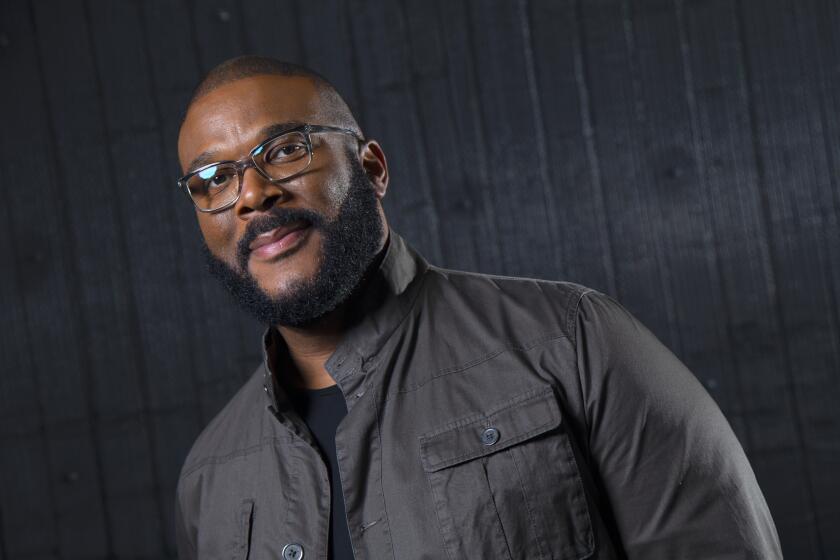DANCE REVIEW : Alvin Ailey Introduces ‘Shards’
- Share via
Alvin Ailey has always had a deep grasp of dance history--of making it as well as preserving it.
Just over 30 years ago, Ailey introduced his brave, new seven-member company to an audience at the 92nd Street YMHA in New York. American dance hasn’t been the same since. Not only did Ailey enlarge the ridiculously limited opportunities for black dancers and radically update the condescendingly exotic image of black dance, he created the nation’s most enduring modern-dance repertory ensemble. Who else dances everything from classics by the pioneers of the art (Ted Shawn, Katherine Dunham) to experiments by young choreographers on loan from the avant-garde (Bill T. Jones, Donald Byrd)?
Now 28-strong, the Ailey ensemble returned to the Wiltern Theatre on Tuesday (sponsored by UCLA) with a relatively sober program spanning the last two decades of its existence (earlier Ailey milestones will come later in the six-day engagement).
From 1969: “Masekela Langage” (music by Hugh Masekela), Ailey’s bitter portrait of bar habitues taking desperate refuge in pop music, drugs, drink and sex to escape the ominous realities of living in South Africa. From 10 years later: “Memoria” (music by Keith Jarrett), his surging, large-scale tribute to the late dancer, choreographer and original Ailey company member, Joyce Trisler.
“Memoria” also represents a slick example of the choreographic style
identified first with Ailey and now,
for better or worse, synonymous with black dance: a collage of balletic extensions, modern-dance torso articulation, percussive social-dance footwork and rhythms plus a major reliance on expressive gesture.
This style is put under a microscope in the final work on the program, Donald Byrd’s impressive “Shards,” a showpiece that’s always easy to watch but also gets at intriguing creative issues. Choreographed last year for a dozen members of the company, it fractures and reassembles the components of Ailey-style in rigorous neo-minimalist terms, with an emphasis on startling contrasts in dynamics.
A dancer’s arm abruptly shoots forward and then is slowly, softly pulled back to graze the face. Formal, balletic turns-in-extension dissolve in wiggly colloquial motion. Gestural statements that resemble streamlined postmodernizations of Ailey’s powerful, recurrent “Buked and Scorned” motif from “Revelations” alternate with sleek passages of dance-as-pure-design.
Such sharp push/pull oppositions become a major rhythm in “Shards,” underpinning the moody wash of sound provided by Mio Morales. But it is classical ballet that increasingly becomes Byrd’s preoccupation (just as it has sometimes been Ailey’s): All the playoffs with other movement forms only heighten the centrality of the ballet vocabulary, repertory and even hierarchy.
In the same way that designer Gabriel Berry’s tiered skirts reconceive the tutu in contemporary terms, Byrd remakes the Rose Adagio for Elizabeth Roxas and four men with the priorities of both past and present intently in focus.
It’s as if he’s trying to define his own place in the continuity of dance tradition by investigating links to Ailey, to Balanchine and to the street. Thus his duets for the statuesque Dana Hash and the muscular Carl Bailey juxtapose lyrical and visceral impulses brilliantly just as his big, super-formal finale almost manages to fuse all the resources of ‘80s American dance in one generous act of homage.
Byrd is best known as a dance rebel, outrageous and fearless. But “Shards” explores his influences and inspirations while transforming them for dancers of his own generation--a surprise, perhaps, but hardly a disappointment.
The Ailey dancers executed “Shards” forcefully on Tuesday, with Bailey in particular relishing every shift of idiom. In “Memoria,” April Berry portrayed the initially suffering and then triumphant central figure very stylishly indeed, but the evening’s most spectacular performance may have been Dereque Whiturs’ dangerously volatile dancing as the jukebox-obsessed junkie in “Masekela Langage.” After 30 years, this company can still confound our expectations--and the proof is at the Wiltern through Sunday.
More to Read
The biggest entertainment stories
Get our big stories about Hollywood, film, television, music, arts, culture and more right in your inbox as soon as they publish.
You may occasionally receive promotional content from the Los Angeles Times.










